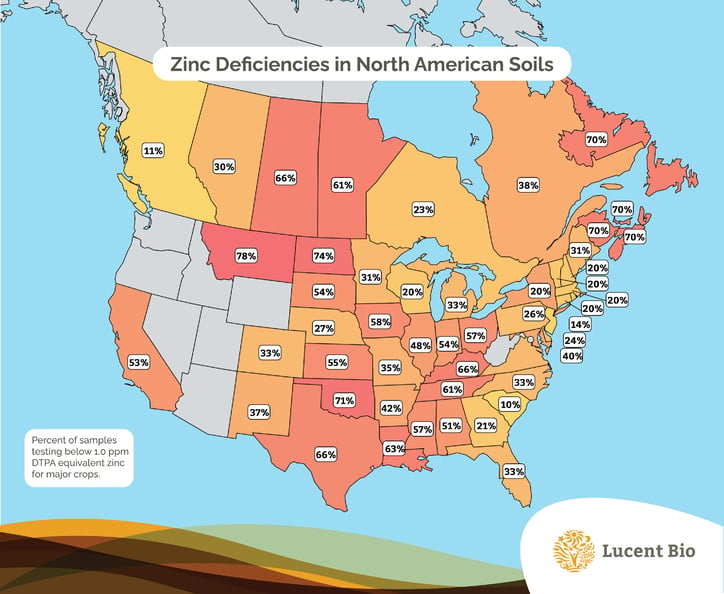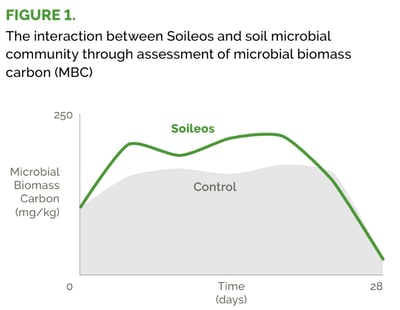Soileos is a soil-applied, smart crop nutrition delivery system.
It enhances yields, crop resilience, and soil health with on-time nutrient delivery and sustained bioavailability, allowing the crop to maximize its genetic potential.
Lucent Bio’s patented technology upcycles cellulose derived from crop processing residues such as lentil, pea, or rice husks into a sustainable delivery agent for nutrients.
.jpg?width=427&height=284&name=IMG_5615%20(white%20bg).jpg)
Soileos is a dry granular product of a similar size and weight to conventional dry granular products. Unlike conventional products, Soileos’ organic substrate means soil organic carbon levels are enhanced through its use. The net result is higher crop yields, improved nutrient density, and healthier soils with higher carbon.
Lucent Bio conducted research on Soileos with Agriculture and Agri-Food Canada to declare the mode of action and the interaction with the soil microbiome with a focus on microbial activity. This research really got the team excited, as after almost a decade of research and development, our COMPLETLY NEW COMPOSITION OF MATTER was ready for this next stage of scientific investigation.
Increasing awareness of soil as an essential ecosystem is a fundamental shift in
how we think about soil and, in turn, how we care for it. Because let's face it, even though it is widely acknowledged that soil biomes are highly important for nutrient and carbon cycling,1 not many people think that soil is a sexy science...
There has been an urgent call to study the intercommunication between plants and microbes, specifically identifying functional roles and interspecies interactions.2
Recent scientific understanding of the extent to which soil biota and plants cofunction and the potential for nature-based microbiome priming to replace synthetic agricultural
inputs have only started to be uncovered.3
Some researchers call this void of information the “final frontier of ecology.” 4
Soil microbiomes enhance plant growth through three processes:
- Hormone manipulations 5,
- Outcompeting and surviving pathogenic microbes,6 7
- Increasing the bioavailability of nutrients in soil microbiomes.8 9
Our research focus' on the third aspect and how Soileos increases bioavailable nutrients in the soil microbiome. We started with Soileos Zinc.
Micronutrient-deficient soils are a global problem that directly impacts human
health. Malnutrition due to the consumption of crops with low dietary value has
ignited the pursuit of more sustainable solutions. According to the World Health
Organization more than two billion people around the world are at risk of zinc
deficiency disorder.10 11 Zinc deficiency is particularly acute in developing countries
where populations rely mostly on cereals for staple food and have little access to
meat.12 In Canada and the USA, 10-12% of the population consumes inadequate
amounts of zinc.13
Climate change is both directly and indirectly affecting interactions between
the soil microbiome and plants by altering community structure, function, and
prosperity.14 15 16 Agricultural soils rely heavily on healthy microbiomes to achieve
high productivity and crop quality.17 Soil ecosystems are one of the largest reservoirs
of biological diversity on Earth; they make up 60% of the Earth’s biomass.18

In agro-ecosystems, zinc deficiency is the most geographically widespread micronutrient constraint limiting crop production. In western Canada, soil samples have shown that zinc is deficient in 30% of those taken in Alberta, 66% in Saskatchewan and 61% in Manitoba.19 Zinc is a critical nutrient because it is essential for plant growth.20 It plays a key role in DNA replication and regulation of gene expression and is vital for germination, chlorophyll production, pollen function, fertilization21, and biomass production.22
Soil becomes zinc deficient when crop removal exceeds zinc availability and
fertilization. Zinc may not be available for plant uptake due to soil characteristics
such as high soil pH or low organic matter content. Zinc is also immobile in the
soil, meaning it cannot travel to plant roots to be taken up unless it is dissolved
and moves with the groundwater.
Soileos Mode of Action
Soileos is the fertilizer of the future. Patented technology binds micronutrients
to cellulose and uses the soil’s natural biological activity to release nutrients to
the crops as required. When Soileos is applied and incorporated into the soil, the
cellulose-bound nutrients are effectively delivered to the plants in a sustainable
method. Nutrients delivered from Soileos to the crop lean on the symbiotic
relationship of microbes and plants; micronutrients are slowly released from the
cellulose of Soileos through microbial mineralization. This is why we call Soileos
Bio-Active.

When soils are fertilized with Soileos, the naturally present microbes begin to consume the organic carbon from the cellulose, increasing their microbial biomass carbon. In this process, they also consume cellulose-bound micronutrients such as zinc. In studies conducted at AAFC, the microbial biomass increased by more than 20% when using Soileos compared to the control (Figure 1).
Once the easily degraded carbon is consumed, the microbial population declines, and the micronutrients are released back into the soil in a bioavailable form for
crop uptake. Unlike synthetic fertilizers, Soileos is an organic fertilizer that fortifies
the soil with natural carbon. Soil life in organic systems such as this can be over
80% more active than in conventional systems.23
The rate of microbial activity is dependent on conditions such as temperature,
moisture, and pH. Warm, moist conditions facilitate a more active microbiome,
whereas cool, dry conditions result in a less active microbiome. This means that
the micronutrients from Soileos are not released from the cellulose until conditions
are met that promote microbial activity. This allows nutrients delivered from Soileos
to become available for plant uptake when the plants need them throughout the
growing season.
Are you still interested in learning how Soileos increases yield through the activation of the microbiome? Just for you, I'll give you our FULL whitepaper - no email required 😉.
References:
1 - Bender, S. F., Wagg, C., & van der Heijden, M. G. A. (2016). An Underground Revolution:
Biodiversity and Soil Ecological Engineering for Agricultural Sustainability. Trends in
Ecology & Evolution, 31(6), 440–452. doi:10.1016/j.tree.2016.02.016
2 - Thijs, S., Sillen, W., Rineau, F., Weyens, N., & Vangronsveld, J. (2016). Towards an enhanced understanding of PLANT–MICROBIOME interactions to Improve Phytoremediation: Engineering THE METAORGANISM. Frontiers in Microbiology, 7. doi:10.3389/fmicb.2016.00341
3 - Jacoby, R., Peukert, M., Succurro, A., Koprivova, A., &; Kopriva, S. (2017). The role of soil
microorganisms in Plant MINERAL Nutrition—current knowledge and future directions.
Frontiers in Plant Science, 8. doi:10.3389/fpls.2017.01617
4 - Paungfoo-Lonhienne, C., Rentsch, D., Robatzek, S., Webb, R. I., Sagulenko, E., Näsholm, T.,. . . Lonhienne, T. G. (2010). Turning the table: Plants consume microbes as a source of
nutrients. PLoS ONE, 5(7). doi:10.1371/journal.pone.0011915
5 - Verbon, E. H., &; Liberman, L. M. (2016). Beneficial microbes affect endogenous
mechanisms controlling root development. Trends in Plant Science, 21(3), 218-229.
doi:10.1016/j.tplants.2016.01.013
6 - Mendes, R., Garbeva, P., &; Raaijmakers, J. M. (2013). The rhizosphere microbiome:
Significance of plant beneficial, plant pathogenic, and human pathogenic microorganisms. FEMS Microbiology Reviews, 37(5), 634-663. doi:10.1111/1574-6976.12028
7 - Berendsen, R. L., Pieterse, C. M. J., & Bakker, P. A. H. M. (2012). The rhizosphere microbiome and plant health. Trends in Plant Science, 17(8), 478–486. doi:10.1016/j.tplants.2012.04.001
8 - Van der Heijden, M. G., Bardgett, R. D., &; Van Straalen, N. M. (2008). The unseen majority: Soil microbes as drivers of plant diversity and productivity in terrestrial ecosystems. Ecology Letters, 11(3), 296-310. doi:10.1111/j.1461-0248.2007.01139.x
9 - Jacoby, R., Peukert, M., Succurro, A., Koprivova, A., &; Kopriva, S. (2017). The role of soil
microorganisms in Plant MINERAL Nutrition—current knowledge and future directions.
Frontiers in Plant Science, 8. doi:10.3389/fpls.2017.01617
10 - World Health Organization (WHO), Food and Agriculture Organization (FAO), International Atomic Energy Association (IAEA), 2002. 2nd ed. World Health Organization, Geneva.
11 - Stein, A. J. (2009). Global impacts of human mineral malnutrition. Plant and Soil, 335(1-2), 133- 154. doi:10.1007/s11104-009-0228-2
12 - Cakmak, I. (2007). Enrichment of cereal grains with zinc: Agronomic or genetic
biofortification? Plant and Soil, 302(1-2), 1-17. doi:10.1007/s11104-007-9466-3
13 - Health Canada. (2012). Do Canadian Adults Meet Their Nutrient ... Retrieved March 19, 2021, from https://www.canada.ca/content/dam/hc-sc/migration/hc-sc/fn-an/alt_formats/
pdf/surveill/nutrition/commun/art-nutr-adult-eng.pdf
14 - Abhilash, P. C., Dubey, R. K., Tripathi, V., Srivastava, P., Verma, J. P., & Singh, H. B. (2013).
Remediation and management of POPs-contaminated soils in a warming climate:
challenges and perspectives. Environmental Science and Pollution Research, 20(8),
5879– 5885. doi:10.1007/s11356-013-1808-5
15 - Tripathi, V., Fraceto, L. F., & Abhilash, P. C. (2015). Sustainable clean-up technologies for
soils contaminated with multiple pollutants: Plant-microbe-pollutant and climate nexus.
Ecological Engineering, 82, 330–335. doi:10.1016/j.ecoleng.2015.05.027
16 - Bojko, O., & Kabala, C. (2017). Organic carbon pools in mountain soils — Sources of
variability and predicted changes in relation to climate and land-use changes. CATENA,
149, 209–220. doi:10.1016/j.catena.2016.09.022
fmicb.2020.01052
18 - Dubey, A., Malla, M. A., Khan, F., Chowdhary, K., Yadav, S., Kumar, A., . . . Khan, M. L. (2019). Soil microbiome: A key player for conservation of soil health under changing climate. Biodiversity and Conservation, 28(8-9), 2405-2429. doi:10.1007/s10531-019-01760-5
19 Murrell, T. Scott & Williams, Ryan & Fixen, Paul & Bruulsema, Tom & williams, elle. (2016).
2015 North American Soil Test Summary.
20 - Marschner’s mineral nutrition of higher plants. (2021). ELSEVIER ACADEMIC Press.
21 - Pandey, N., Pathak, G. C., & Sharma, C. P. (2006). Zinc is critically required for pollen
function and fertilization in lentil. Journal of Trace Elements in Medicine and Biology, 20(2), 89-96. doi:10.1016/j.jtemb.2005.09.006
22 Kaya, C., & Higgs, D. (2002). Response of tomato (Lycopersicon esculentum l.) cultivars to foliar application of zinc when grown in sand culture at low zinc. Scientia Horticulturae, 93(1), 53-64. doi:10.1016/s0304-4238(01)00310-7
23 - Lori, M.; Symnaczik, S.; Mäder, P.; Deyn, G.D.; Gattinger, A. Organic farming enhances soil microbial abundance and activity—A meta-analysis and meta-regression. PLOS ONE 2017, 12, e0180442, doi:10.1371/journal.pone.0180442.
